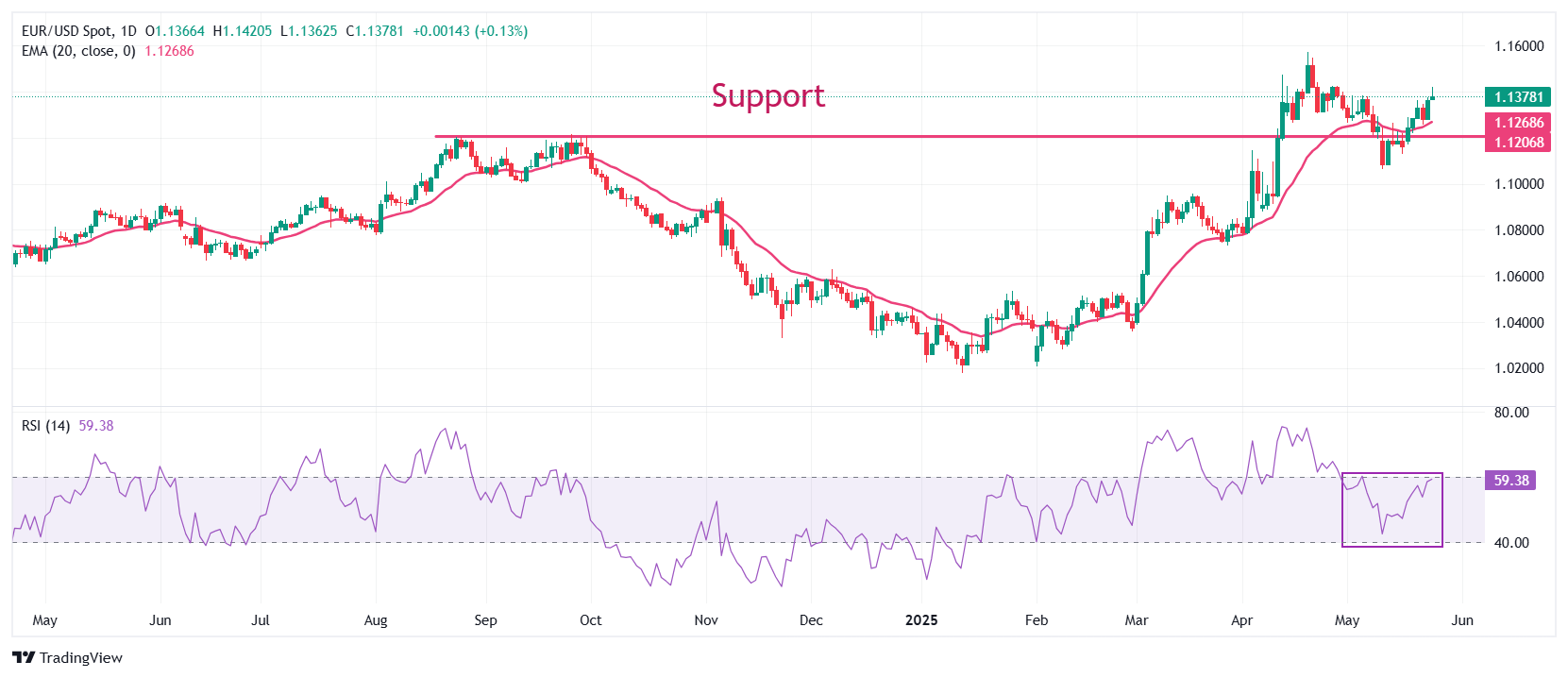-
EUR/USD edges up toward 1.1420 as Trump’s unpredictable policy shifts spark fresh doubts about the USD’s reliability.
-
Revised figures show Germany’s economy expanded at a solid 0.4% in Q1.
-
Investors this week will keep a close eye on inflation data from both the EU and the US.
EUR/USD soared above the 1.1400 mark during European trading on Monday, reaching its highest level this month. The pair’s rally was driven by renewed pressure on the US Dollar (USD), which has lost ground following inconsistent statements from Washington regarding tariff policies. The US Dollar Index (DXY), which measures the USD against a basket of six major currencies, slipped below the 99.00 threshold.
Over the weekend, President Trump walked back his threat to impose a flat 50% tariff on European Union (EU) imports. Originally set to take effect on June 1, the decision has now been postponed until July 9 after the EU agreed to fast-track trade negotiations. European Commission President Ursula von der Leyen confirmed via a post on X (formerly Twitter) that she had a “good” conversation with Trump and that the EU is ready to move forward with talks. She noted, “To reach a good deal, we would need the time until July 9.”
The temporary de-escalation has eased trade tensions between the US and EU, boosting sentiment in equity markets and lifting the Euro. However, the abrupt shift in US policy has further undermined confidence in the USD.
The Greenback has come under mounting pressure in recent months amid Trump’s unpredictable tariff announcements, speculation about removing Federal Reserve Chair Jerome Powell, and proposals for new tax cuts and spending packages projected to add $3.8 trillion to the national debt. These developments have diminished the USD's safe-haven status and bolstered demand for the Euro. Analysts at ING remarked, “We think the euro is continuing to benefit from being the most liquid alternative to the dollar.”
Euro Gains Support from Strong German GDP Data
- Beyond the USD's decline, the Euro has found additional strength from upbeat economic data. Revised figures show Germany’s Q1 GDP grew by 0.4%, up from initial estimates and the previous reading of 0.2%. The data alleviated fears of a potential economic contraction, especially after two consecutive years of declines.
- Deutsche Bank Research noted that the stronger-than-expected GDP indicates Germany may avoid stagnation in 2025. Analysts anticipate continued growth in the second half of the year, despite possible setbacks from US trade policy.
- On the monetary policy front, optimism is rising within the European Central Bank (ECB) that inflation could return to the 2% target by year-end. This has strengthened market expectations for another rate cut at the ECB’s June meeting. ECB Governing Council member and Bank of Greece Governor Yannis Stournaras voiced support for easing, stating, “I expect one more interest rate cut in June and then a pause,” in comments published Friday.
- Looking ahead, the EUR/USD pair will be guided by key inflation data: the US Personal Consumption Expenditures (PCE) Price Index for April and the Harmonized Index of Consumer Prices (HICP) for major EU economies, both scheduled for release on Friday.
Technical Outlook: Bullish Momentum Builds

Technically, EUR/USD climbed to a nearly one-month high near 1.1420 at the week’s open. The pair is trading above its 20-day Exponential Moving Average (EMA) at around 1.1270, signaling bullish momentum.
The 14-period Relative Strength Index (RSI) is approaching 60.00; a break above this level could trigger further buying interest.
On the upside, the April 21 high at 1.1475 serves as a key resistance. On the downside, the September 25 high of 1.1215 stands as critical support for the bulls.





